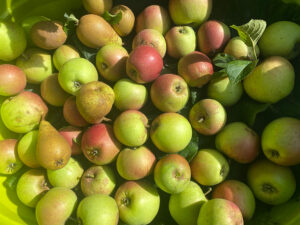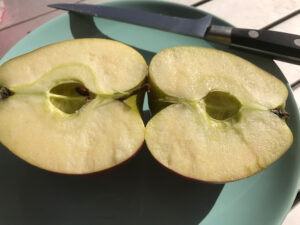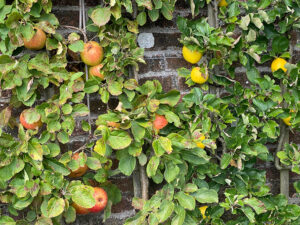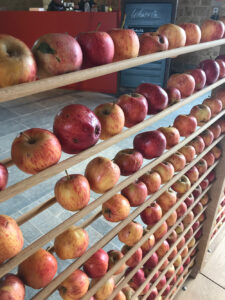
With the fruit trees laden with apples, it’s time to harvest, store and appreciate this humble fruit.
Some years are better than others for different garden fruits and this year my apple trees are loaded with large juicy fruits. I’ve never seen such huge apples hanging from the branches and have to assume that the deluges of rain this summer have fattened the fruit. But as yet they are unripe and extremely tart and I fear for their flavour.
With a persistent and very cheeky squirrel also eying up the fruit bounty, I decided to act fast and harvest at least half of the apples. They were fairly quick to release from the stems suggesting that my timing was pretty good, though once cut in half it is clear that the seeds are still white, a sure sign that they need longer to ripen. Not to mention the sour taste needs offsetting before I attempt to eat, cook and preserve this crop of delicious apples.
Greenhouse secrets

Where to store any garden surplus can be a dilemma but with the cooler temperatures of the last few weeks, my greenhouse beckoned, offering a sheltered space to not only keep the apples out of the rain and the greedy paws of my squirrel friends, but also to enhance and speed the ripening process. It didn’t take long for the first picked batch to start to blush with more golden hues. A quick dissection with a sharp knife revealed brown seeds inside and while the flesh was still a bit sharp in taste, it was fresh, juicy and very tasty.
I don’t want all my apples to ripen too fast as I plan to use each and every one of them in jams (the high pectin levels help other jams to set), sauces, cakes and chutneys, but to be able to cross apples of the shopping list in early September is fantastic. Now to find more ways to use these versatile fruits and their health benefits.
Apple power

An apple a day keeps the doctor away has more than a pip of truth in it. A little disclaimer here – I am not a medical professional in any shape or form and this is not medical advice. But it seems to me that fresh apples are good for us in many different ways. Not only are they packed full of vitamins, but apples are full of fibre which supports our gut health. And these humble fruits can also detox the body, enhancing the removal of toxins and even heavy metals from the body, just by eating them.
But there is a way to scale up apple power and make them even more beneficial to us. First and possibly the most important thing is to grow them without the addition of any chemicals
Pollination

Improve fruit pollination not by putting in a bee hive but by supporting our wild pollinators like the solitary bees. These unsung heroes are often better pollinators than our honey making friends, because they are messy bees, getting covered in pollen as they move from flower to flower, effecting pollination. One mason bee does the pollination work of 120 honeybees and without the hassle of a hive and for free! And mason bees are already in our gardens. These are some of the bees that might nest in our insect houses and they emerge just as our apples come into flower, raiding the apple blossom for nectar and pollen, pollinating as they go.
If you want to support these unsung heroes, dump the toxins, keep a muddy puddle in the garden, they use mud to make their nests and grow more spring flowers where they can access the pollen and nectar and of course fruit trees are a great place to start.
Windfalls and juicing

And if you don’t have room for apple trees in your garden, scout around your neighbourhood and offer your services to collect up windfalls from neglected trees. While some of these will feed the fruit eating wildlife, many can be offered to communities, added to food bank schemes or gathered up for juicing. Look out for community juicing projects that transform your windfalls into apple cider vinegar, cider and juice. Make each and every apple count. Use them to gently inform the youngsters so that they understand where their food comes from and the part it plays in the food chain. But most of all, make sure you imbibe at least one apple a day, just in case it really does keep the doctor away.










